





Almost any gardener who has driven along a coastal highway in the southeastern United States has caught a glimpse of the indigenous wild sea oats along the sand dunes. If you have walked along those beaches, you will have seen signs that picking sea oats (or any part thereof, including seeds) is against the law in several states, and carries a hefty fine.
What is so tantalizing about sea oats, making one wish to break the law to have sea oats in their own garden? For starters, they have a striking appearance growing and swaying in the slightest breeze. The decorative plumes (seed heads) are often dried and placed in floral arrangements, or displayed alone as a focal point. Sea oats are quite easy to have without breaking the law, but few people are aware seeds and/or plants may be bought legally from nurserymen licensed by the state of Florida to propagate them. These nurseries supply sea oat plants to local, state and federal government agencies for dune restoration after hurricanes; the nurseries are allowed to sell them to the public as well.
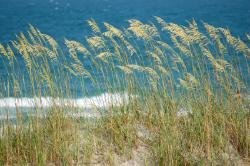
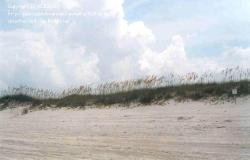
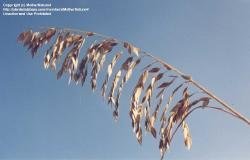 Sea Oats on sand
Sea Oats dune
Sea Oats plume
Sea Oats on sand
Sea Oats dune
Sea Oats plume
Another reason sea oats are unlawfully picked is because many folks don’t really know or understand the importance of sea oats in protecting our shorelines. When ocean waves wash up on the beaches, they deposit organic material on the sand. As organic matter builds up, it provides a nutrient cache that allows seeds to germinate, and those seeds begin to send roots down into the sand. Once there is just a tiny bit of rooted plant matter growing, it increases in ability to collect more organic matter, which roots and puts down roots… eventually becoming a cluster that traps more bits of sand carried by sea water and air currents, and begins to grow into a sand dune.
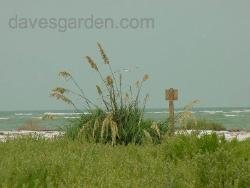
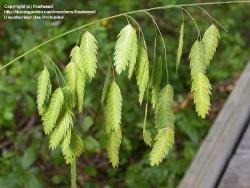
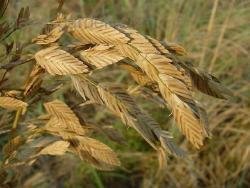 Sea Grass clump
Young sea grass seeds
Mature sea grass seeds
Sea Grass clump
Young sea grass seeds
Mature sea grass seeds
Dunes get larger by trapping more sand, which then grows more plants to anchor the sand. It’s an endless cycle, broken only by major storms like hurricanes capable of destroying the fragile dunes. The dune ecosystem harbors more than just sea oats although that is the most common plant. As dunes grow larger, they become inhabited by palmetto plants, sea grapes, and cabbage palms, among other varieties. Some very large dunes support trees like live oaks and pines. “Primary dune systems that have been cut away by hurricanes reveal original clumps of sea oats in the dune profile with underground stems (rhizomes) and roots reaching up to 9 meters (30 feet) below the top of the dune. The fibrous roots of these plants usually extend to the upper parts of the water table, some 12 meters (40 feet) below the dune’s peak in some places. The vertical taproot alone can grow up to 3.5 meters (12 feet).” [1]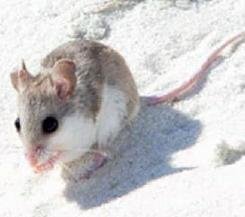 Sand dunes with a good stand of sea oats are often inhabited by the Beach Mouse (Peromyscus polionotus), a federally endangered species also called Oldfield or Deer Mouse. (Sea oat seeds are a food source for them.) Other listed subspecies include Choctawhatchee Beach Mouse (P. p. allophrys), Alabama Beach Mouse (P. p. ammobates), Perdido Key Beach Mouse (P. p. trissyllepsis), and Andrew Beach Mouse (P. p. peninsularis). Sand dunes also benefit from nesting sea turtles. The thousands of sea turtle eggs that never hatch, and the hatchlings that never make it to the water all deposit nutrients (organic matter) that nourish the fragile plants of the dunes. A decline in sea turtle populations means fewer eggs, thus fewer nutrients for the dune plants and higher risk for beach erosion.
Sand dunes with a good stand of sea oats are often inhabited by the Beach Mouse (Peromyscus polionotus), a federally endangered species also called Oldfield or Deer Mouse. (Sea oat seeds are a food source for them.) Other listed subspecies include Choctawhatchee Beach Mouse (P. p. allophrys), Alabama Beach Mouse (P. p. ammobates), Perdido Key Beach Mouse (P. p. trissyllepsis), and Andrew Beach Mouse (P. p. peninsularis). Sand dunes also benefit from nesting sea turtles. The thousands of sea turtle eggs that never hatch, and the hatchlings that never make it to the water all deposit nutrients (organic matter) that nourish the fragile plants of the dunes. A decline in sea turtle populations means fewer eggs, thus fewer nutrients for the dune plants and higher risk for beach erosion.
Sea oats stabilize existing sand dunes, and the dunes in turn provide a barrier from storm surges to ocean property. Sea oats are generally pretty hardy plants although easily destroyed by foot traffic along the beaches. “Once planted, the six-inch seedlings will mature and begin producing seed in two years or less. Survival rate for the seedlings could be anywhere from 5 to 85 percent, depending on factors such as irrigation and future foot traffic.” [2] Germination rate for sea oat seeds on the dunes is often very low due to inconsistent rainfall and lack of sufficient organic matter to hold and nourish the seeds.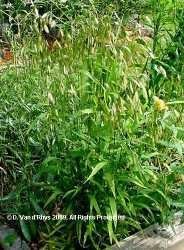 To grow sea oats (Uniola paniculata) in the home garden requires only average water and soil in full to partial sun, but do not allow the ground to dry out completely between waterings. They are hardy to USDA Zone 6, and will form slowly-growing rhizomes which may be divided for propagation. The plumes can reach a height of 4 to 6 feet; seeds can become quickly invasive, so gather the seeds before they scatter. Propagation from seed may be accomplished by direct sowing after the last frost of the season.
To grow sea oats (Uniola paniculata) in the home garden requires only average water and soil in full to partial sun, but do not allow the ground to dry out completely between waterings. They are hardy to USDA Zone 6, and will form slowly-growing rhizomes which may be divided for propagation. The plumes can reach a height of 4 to 6 feet; seeds can become quickly invasive, so gather the seeds before they scatter. Propagation from seed may be accomplished by direct sowing after the last frost of the season.
There are some other grasses quite similar and used as a substitute for sea oats in the home garden. These plants are known as northern sea oats, aka river oats, spangle grass, indian woodoats, broadleaf spike grass and inland sea oats; the botanical name is Chasmanthium latifolium (synonym Uniola latifolia). They are a hardier perennial (to Zone 5a) than wild sea oats, occurring naturally along stream banks and forest valleys from the eastern United States west to Nebraska, Texas and Mexico. They are generally available in garden nurseries and I have some growing in my own yard (shown in left photo).
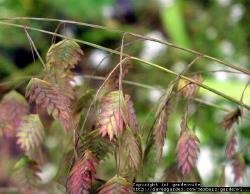 I hope this will encourage you to plant some of this legal striking ornamental sea oat grass or one of its cousins in your garden, and encourage others to heed the laws protecting the wild sea oats that protect the shorelines for all of us.
I hope this will encourage you to plant some of this legal striking ornamental sea oat grass or one of its cousins in your garden, and encourage others to heed the laws protecting the wild sea oats that protect the shorelines for all of us.
End Notes
[1] http://www.knowtheconnection.com/int_seaoats.htm
[2] http://news.ufl.edu/2002/04/19/seaoats/
Click here for mail order sources of sea oats. Another source is Coastal Native Plant Specialties, Inc. For other sources, ask your local Extension Service, or contact the Florida State Conservation folks.
Photo Credits
I’d like to thank the following photographers for use of their photos from PlantFiles: ADKSpirit, Floridian (2), Frostweed, MotherNature4 (thumbnail photo) and NativePlantFan9: Sea Oats photos. Gardenwife: Northern Sea Oats photos. The other Northern Sea Oats photo is © by the author.
Beach Mouse photo is in the Public Domain
Sea Oats iStock photo #: 2764444, © steve vanhorn, Used by Permission
Copyright © www.100flowers.win Botanic Garden All Rights Reserved